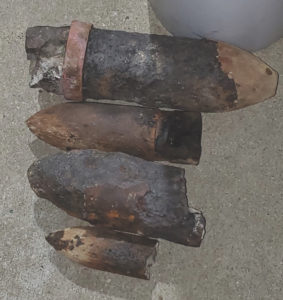WELLFLEET — While doing landscaping chores on Sept. 12, Donald Thimas came across nine World War I-era bombs, including six powerful anti-tank devices that later rocked neighborhoods when they were exploded by the U.S. Navy and state police bomb squads.
“I saw what looked like a pipe sticking out of the ground, and I found these things and they were fairly shallow,” said Thimas, who has lived at 2013 State Highway for 16 years.

He dug around with his hands and unearthed about five or six rusted metal objects before he stopped and said, “I think I’ll call the fire department.”
Thimas knew he was dealing with bombs; they all looked like “large bullets,” he said.
But how did they get into his yard?
“I have no idea,” he said.
The home was constructed in 1950 and the previous owners have no obvious military connection, he told the Independent.
Thimas’s home isn’t near Camp Wellfleet, the former military base that is now in the Cape Cod National Seashore. He guessed that someone found them elsewhere and buried them many years ago. Fishing draggers do recover bombs with some regularity, he said.
About once or twice a year, the Wellfleet Fire Dept. is notified about small World War II devices found on Marconi Beach or areas near the former base, said Fire Chief Richard Pauley.
“Most of the time, you only need a minor amount of C4,” said Pauley, referring to the explosive material used to detonate old bombs. “But six of these were anti-tank, so it took a lot to have them neutralized.”
The State Police Bomb Squad joined firefighters at 5 p.m. and attempted to X-ray the explosives to see if there was live material inside. But the armor was too thick, Pauley said.
There were four 12-to-14-inch armor-piercing anti-tank grenade shells, two nine-inch anti-tank type grenades, and three smaller target shooting type explosives, Pauley said.
Two U.S. Navy bomb technicians who arrived at 8:15 p.m. by helicopter managed to X-ray them and found that all of the explosives were “live/active, highly unstable, military grade and of the World War I era,” Pauley wrote in a prepared statement.
The DPW filled a dump truck with sand to transport the bombs to the sand pit at the transfer station.
The bombs were buried in yards of sand and detonated in four explosions; the last one so powerful that homes around the transfer station vibrated and the sound carried across the highway to Pauley’s house at Gross Hill Road, he said.
Pauley said many people were alarmed by the sound and complained that they should have been warned. He understood their perspective, but Pauley made the decision to keep the detonation on the down low, because he did not want a crowd to gather and watch.
“We wanted to keep people safe,” he said. “It took an hour to destroy these things. Six of them were anti-tank. They can do great harm.”



